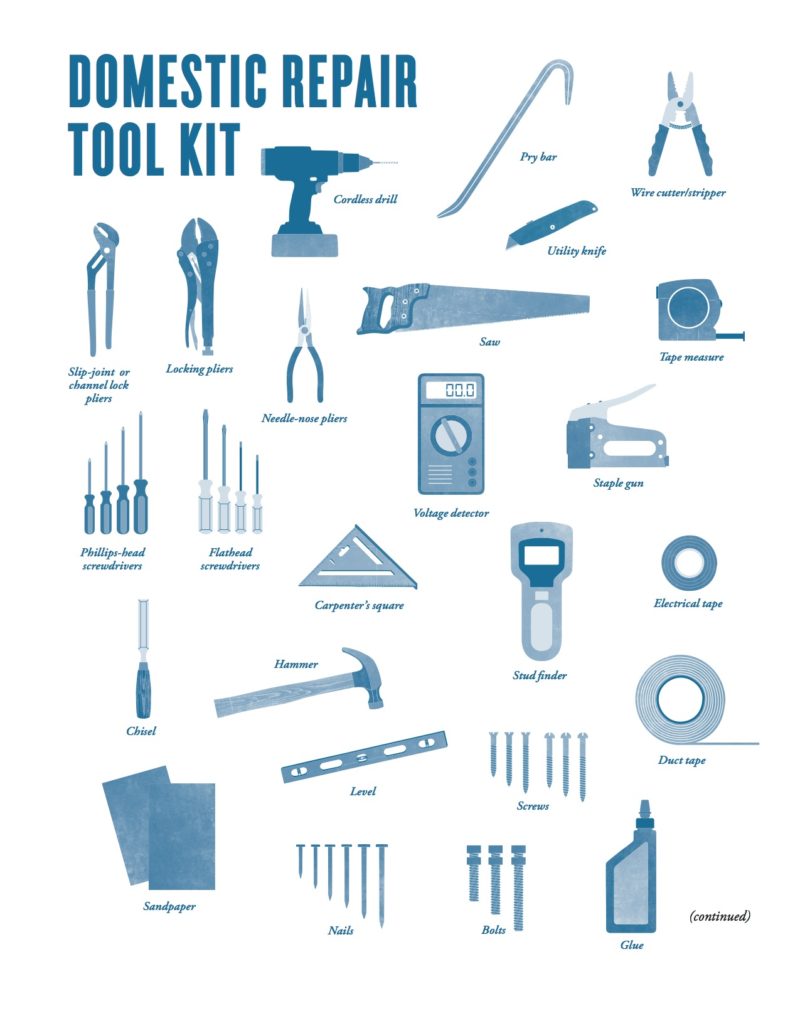One Sunday’s to-do list might include anything from fixing a leak, to painting a shelf, to banging down stray deck boards, to putting a new blade on the lawn mower, to hanging a picture. How can you predict what you’ll need next Sunday? You can’t, which is why your home tool kit needs to be flexible, complete—and organized! A trip to the hardware store for a screw or tool that you know is hiding somewhere in the garage can turn a two-minute fix into a two-hour job. Having the right tool on hand can also be the difference between an easy DIY job and a costly call to the handyman. Spending $200 on tools now can save you many times that amount later.
Here are the tools you should have in your domestic repair toolkit, excerpted from Sharon and David Bowers’ The Useful Book..

Hammer. You can’t go wrong with a lightweight framing hammer—such as a 20-ounce, smooth-faced model with a straight claw.
Screwdrivers. A medium and a large Phillips ( + ) and flathead ( – ) is a great place to start.
Tape measure. A 1-inch-wide, 25-foot-long tape measure is indispensable. Make sure it’s high enough quality to assure a working lock and well-made retrieval spring.
Pry bar. A short cat’s paw pry bar will do just fine to pull nails and lift floorboards.
Locking pliers. Why burn your own grip strength to hold pliers closed? Instead, a pair of versatile, locking Vise-Grips are essential for keeping most things pinched around the house. Consider a pair of Irwin 10-inch curve pliers.
Needle-nose pliers. These are meant for electrical work—to bend and cut wires—but you’ll use them for everything from pinching tiny screws to pulling large splinters.
Slip-joint pliers. The most common pliers are two-position, slip-joint pliers, which allow you to close tight in one position and grip large objects in the other. Plastic-coated or otherwise, padded handles are a plus.
Wire cutter/stripper. Go with a multi-size wire cutter/stripper, which you’ll use when rewiring lamps and hanging light fixtures.
Voltage detector. You’ll need a voltage detector to help locate the source of the trouble in light fixtures, circuit breakers, wires, and cables.
Cordless drill. Look for a variable speed, reversible, twist-lock model with a good set of bits. In addition to a kit of standard bits in a range of sizes, you might want a couple of spade bits, a masonry bit, a hole cutter, and bits used for driving screws (Phillips and flathead).
Chisel. Get a wood chisel, and try to keep it for shaving wood off a loose door jamb instead of opening paint cans.
Saw. A straight handsaw will cut boards quickly and even trim the odd tree branch in a pinch.
Level. You can get a pen-sized laser level for about the same price as a four-foot bubble level, and you will find pros who swear by each. Pick one or the other.
Stud finder. Yes, you can knock on the wall until the hollow sound goes solid, but while you hone your 2 × 4 divination skills, get a stud finder.
Utility knife. A retractable-blade utility knife will do everything from cutting carpet to opening boxes.
Carpenter’s square. Carpenters use an L-shaped or triangular steel or aluminum square when building with 2 × 4s. You’ll want one around to double-check the angles of the broken picture frame you tacked back together.
Staple gun. A well-made, hand-powered staple gun is essential for hanging holiday lights and tacking upholstered furniture. Make sure the gun you buy accepts staples up to 5⁄8″ and ask a salesperson if you can give the staple gun a few test squeezes before buying. Buy a range of staples—½” and 3/8″ are the most useful.
Electrical tape. There are some jobs that require exactly the right gear, and rewiring is one of them. For splicing even the smallest wires, you need vinyl electrical tape, which stretches, adheres to, and insulates wires.
Duct tape. It binds the world together.
Sandpaper. Common aluminum oxide sandpaper runs from the coarse grit of P12 to the ne grit of P220 (and even higher for finish papers). Usually you’ll use a coarse paper first and finish with a finer grit, so it’s worth buying a set.
Nails, screws, and bolts. Even the most basic home repair tool kit should include a range of nails—ranging from 4d (1½ “) to 16d (3½”)—and screws. Wood and drywall screws have coarse threads, whereas metal screws have finer threads. Get a range of both. It’s also worth having a couple of carriage bolts, eye bolts, and screw eyes on hand.
Glue. Super glue, wood glue, Elmer’s glue, maybe an epoxy for special projects. Along with duct tape, glue will hold everything together.





No Comments